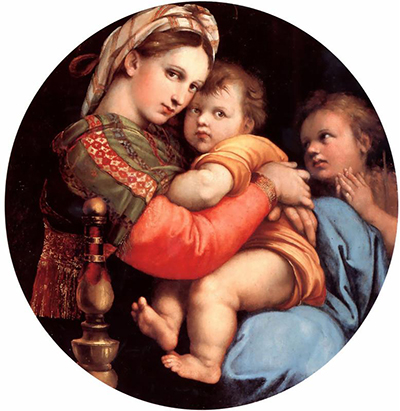The Madonna Della sedia commonly known as the Madonna of the chair is a painting by an Italian artist Raphael dating back to 1513 -1514. It is currently housed in the Palazzo Pitti collection, Florence.
The painting depicts Mary, the mother of Jesus embracing a young child who is the Christ, while John the Baptist devoutly watches. This artistic work was executed during the Roman period. It does not have a strict geometrical form and the linear style of his Florentine treatments of the similar subject. Instead, its warmer colours seem to show the influence of the famous Titian and his rival Sebastiano Del Piombo.
His earliest techniques and paintings coincided with the increasing use of oil paint in his country, Italy. Most of his paintings executed on the panel seem to use the paint. Also, in many of his offerings, Raphael used egg tempera, which was a mixture common with various artists of his generation.
Before settling in Rome, most of his paintings were executed on animal skins or a piece of paper. In his artistic work, he used a medium that was a type of watercolour in which its pigments were bound in animal glue. Before settling on his colours, Raphael performed several experiments with the oil medium and watercolour in order to achieve the beautiful colour variations, richer colours and the greater depth of shadow. While working on the Madonna of the chair, Raphael employed several assistants before having talented pupils and associates.
His technique and style changed significantly while in Florence, and he used pen and ink to complete this painting. Most of the work was rougher, and his large and complex colour compositions were regarded as the classic arts of a high Renaissance. During this period, Raphael had to learn the Florentine methods of creating up a combination with the pyramidal figure masses. They were then brought together as independent units, but they retained their original shape. The unity of the composition and the suppression of the inessentials is what differentiate the appearance of the painting. The style he used provides a unique and highly idealized depiction of the entire forms represented in the painting.
In many paintings, including the Madonna of the chair, Raphael looked to design and develops calmer and extroverted style which would serve as famous and universally accessible forms of visual communications.
This paint provides or delivers a vivid image of Mary, John the Baptist and baby Jesus with maximum colour accuracy and the exceptional resolution. The painting engages you or any other viewer directly as Mary sits closely confined within a circular format affectionately and carefully cuddling her young one, the infant Jesus Christ. On the right of the Madonna, the child Raphael depicts John the Baptist who is Christ's younger cousin. He painted this work while in Rome, and the child was added shortly after his work on Vatican Stanza. The Madonna of the chair was taken by Napoleon’s troops in the year 1799 before being returned to Florence in the year 1815.




